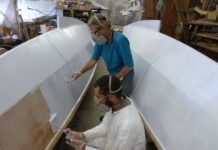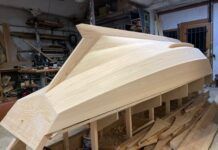Often seemingly minor problems on boats are indicators of more serious problems that, if not addressed early, will lead to bigger headaches and more expensive repairs. Gelcoat cracking on the deck, which can be either a harmless cosmetic problem or a symptom of wet core or some other structural failure, is a classic example of this scenario.
Your keel seam falls into the same category. It might easily be resolved with some underwater sealant, or it could be a symptom of a far more serious problem. Without dropping and inspecting the keel, you cannot know for sure. Given that this iron keel is 28 years old, the likelihood of serious corrosion between the stub and the ballast is significant. The keel bolts themselves may also be corroded. If your keel has never been dropped and inspected before, a close inspection is long overdue, particularly if you plan to take the boat offshore or beyond coastal waters.
Even if all is well with your keel assembly, it is unlikely that you will permanently seal your keel seam without some thorough prep work at the joint. Certainly, you may be able to fill the seam with a good adhesive sealant like you did before, but it will likely open again over time and you will not solve any larger hidden problems.
Once your inspection and any repairs are taken care of, achieving a proper seal will ensure this problem doesn’t crop up again. To get a good seal, both the keel stub and ballast must fit cleanly together. In other words, the mating surfaces should be uniform and flush. Typically, the joint would require a minimum of sealant, most of which squeezes out of the joint upon tightening the keel bolts. If there was a poor fit to start with, more sealant isn’t the answer.
The ballast needs to be removed, the surfaces cleaned, and a high-density epoxy filler will be required to fill the voids.
Once your keel stub is relatively smooth and free of voids, you can use it to “mold” a clean mating surface in the keel. To do this, you need a sheet of heavy polyethylene plastic that will fit like a gasket between the keel stub and keel and keep the two from bonding. For extra protection, you should cover both sides of the “gasket” in a mold release wax, or similar mold release agent. You must also make sure the keel bolts are liberally coated and packed in grease. A failure to ensure a clean release here can cause some significant problems. You then fill the voids in the mating surface of the ballast keel with putty or high-density Chockfast (www.chockfast.com). The hull and its plastic gasket is then lowered back onto the epoxy-filled ballast (with the plastic in between the hull and putty-coated keel), and the excess epoxy squeezes out evenly, developing a flush fit. Any excess epoxy should be cleaned away with a putty knife or plastic spreader. Once the epoxy has cured, the hull is again lifted, and the epoxy and grease residue are thoroughly cleaned. Finally, the hull/ballast joint is bedded with a polysulfide or polyurethane adhesive meant for underwater service. The parts are mated and lightly bolted up. Dont make the final torque adjustments until the sealant has fully cured.
For more advice on how to inspect and repair your boat and boats keel, purchase This Old Boat, 2nd Edition from Practical Sailor today!







































